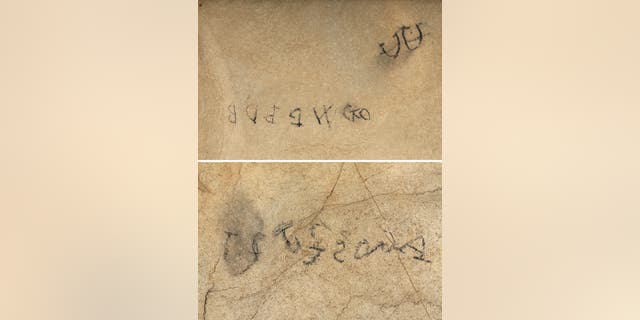Here's some more cave drawings.
View attachment 255344
where did you get those pictures from........ any link to a story?
just a fast search
Ancient Dinosaur Depictions | Genesis Park
Ancient Dinosaur Depictions
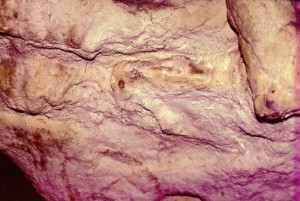
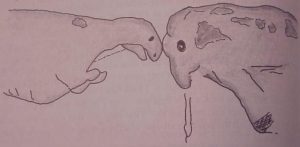
To the right is a picture of what appears to be a bipedal dinosaur with small arms in head-to-head combat with a mammoth from the book
Buried Alive by Dr. Jack Cuozzo (click to enlarge). It was taken by the author in Bernifal Cave, one of the caverns in France that is renowned for Neanderthal art. Mammoth drawings are not unusual in such cave art, but the depiction of an apparent theropod dinosaur is remarkable.
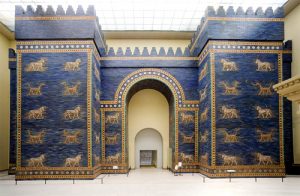
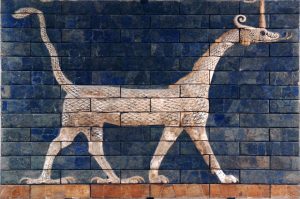
In 600 BC, under the reign of King Nebuchadnezzar, a Babylonian artist was commissioned to shape reliefs of animals on the structures associated with the Ishtar Gate. Many centuries later German archaeologist Robert Koldewey stumbled upon the blue-glazed brick and that gate was rediscovered in 1899. The animals appear in alternating rows with lions, fierce bulls (rimi or reems in Chaldean), and curious long-necked dragons (sirrush). The lions and bulls would have been present at that time in the Middle East. But, on what creature did the ancient Babylonians model the dragon? (click the depiction to enlarge) Koldewey believed that the sirrush was a portrayal of a real animal and in 1918, he proposed that the dinosaur
Iguanodon was the closest known match to the sirrush. The same word, sirrush, is mentioned in the book of Bel and the Dragon, from the
Apocrypha. Both the description there and the image on these unearthed walls, which are now displayed in the Berlin Vorderasiatisches Museum, appear to fit a sauropod dinosaur. (Shuker, Karl P.N., “The Sirrush of Babylon,”
Dragons: A Natural History, 1995, pp. 70-73.)
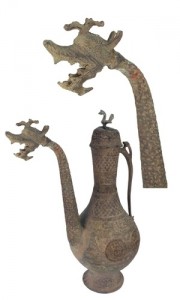
To the right is a bronze Persian pot manufactured toward the end of the 1st Millennium AD that is part of the Genesis Park collection. The most fascinating element of this vessel is the stylized, scaled dinosaur-like dragon that forms the spout. Dragons form an integral part of Persian mythology and beliefs. The ceremonial undertones of this vessel lead us to believe that it was associated with Zoroastrianism. Several malevolent dragon-like creatures are mentioned at various points in the Zoroastrian scriptures. One such popular dragon myth involves Azi Dahaka – a three-headed Persian dragon that will devour one third of all men and animals at the end of the world.
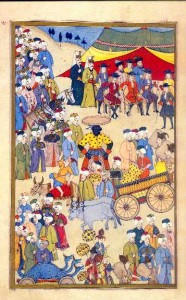
Although the Ottoman Empire ruled for over six centuries, there are not many depictions of dinosaurian creatures in their artwork (as compared to Medieval European art). Perhaps dragons were not as common in the eastern European/Middle East theater at that time. The Turkish painting to the left, entitled “Procession of the Trade Corporation during the Festival of 1720 in Constantinople” is in a surname (or historical album) called
The Surname-I Hümayun archived at Topkapi Museum of Istanbul. It was written and illustrated under the direction of Abdulcelil Levni (aka Abdulcelil Çelebi) who was the official Ottoman court painter till he died in 1732. The picture shows the guildsmen, followed by clowns and what seems to be a mechanical three-headed dragon. (Click for an enlargement of the dragon.) Note the similarity to a baby sauropod dinosaur. A
sauropod with multiple heads, a condition known as polycephaly, while curious, is hardly unknown among dinosaur reports.
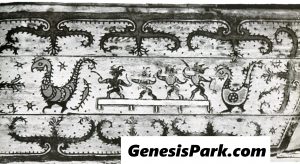
Up till the colonial period of the 1800s the Dayak peoples of Borneo and Sumatra produced multiple pieces of art depicting long-tailed, long-necked creatures with a headcrest. Dayak mythology tells of a time, before the creation of man, when the sea was the home of a mighty underworld dragon who opposed the gods of the sky. The artwork to the right seems to show warriors on a platform fighting crested dragon-like animals. The creatures on this particular art, which is housed in the Ethnographical Museum of Budapest, bear a striking resemblance to the hadrosaurids species
Corythosaurus and
Lambeosaurus. They are apparently being hunted by these ancient Indonesian peoples. (Bodrogi, Tibor,
Art of Indonesia, 1972, plate 10.)

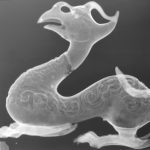
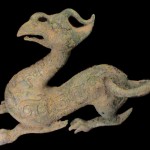
Chinese stories and stylized dragon depictions are fairly common. But an unusual beaked dragon statue came up on the antiquities market and is now in the Genesis Park collection. The bronze styling on this artifact suggests it is from the Han Dynasty (206 B.C. – A.D. 220). It displays numerous characteristics of the beaked dinosaurs (like the
Oviraptor depicted alongside for comparison): tridactyl feet configuration, metatarsal stance, scale-like representation all over the body (except for the horn which has a striated pattern), long (albeit slender) tail, elaborate head crest and a long neck. This piece was submitted for industrial X-Ray authentication and the patina was also chemically tested, showing that the artifact was clearly genuine. A beautifully preserved beaked dinosaur mummy (
Edmontosaurus) was discovered in Alberta, Canada in 2013. The specimen sported a fleshy crest atop its head (like a rooster). Researchers theorized that the hat-like ornament was brightly colored to allow for identification. This was the first non-bony crest discovered on a dinosaur. It closely matches the look of the Chinese beaked dragon.
